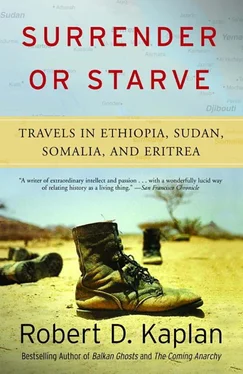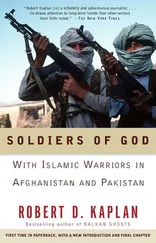ERA’s ultimate aim is to resettle all 100,000 of these refugees, in addition to several hundred thousand more by the end of the decade, at a cost to foreign donors of $25 million. But, from the looks of the plans and the way ERA officials talk, about the only similarity between this resettlement scheme and the one organized by the Ethiopian government is the name. In Ethiopia, resettlement has sparked an international outcry, with several studies indicating that up to one hundred thousand people have died in the program due to poor planning and brutal treatment of the peasants at the hands of Marxist cadres. Moreover, no food, drinking water, or tools of any kind reportedly were available when peasants arrived at the new sites. In Eritrea, on the other hand, officials always emphasize that resettlement will be carried out only “as conditions permit.” ERA documents list not only the exact amounts and kinds of seed, tool, insecticide, and other equipment needed at each site before it can be occupied, but the cost of each item, too.
Yet, despite the surfeit of pronouncements by relief experts, politicians, and journalists about the “need for Africans to help themselves,” and despite public disgust about the misuse of aid by the Ethiopian government, it wasn’t until mid 1985, when the food situation in government-held areas already was being brought under control, that donations to ERA—a group that was doing nothing if not helping itself and efficiently utilizing available resources—began to proportionately catch up with donations earmarked for Ethiopia. At the end of March 1985, in Orotta, Tekie Beyene, the ERA information officer, complained to me that “we have publicized our food situation for five years but only now does the international community begin to listen. Compared to what is happening in Ethiopia, we have saved our own people.”
A look at the military map in mid 1985 revealed that nearly half of the areas affected by famine were in the hands of some guerrilla group, be it the Eritreans, the Tigreans, or one of the smaller bands operating in Gondar or Wollo. The so-called Ethiopian famine was in part a misnomer in the sense that the Ethiopian capital was not the address for many of the victims. By all neutral estimates, several million of the eight to ten million peasants facing starvation lived in areas that could be reached only by ERA or REST. As Dan Connell, a former Reuters correspondent and executive director of the Cambridge, Massachusetts–based relief information service, Grassroots International, told The Nation (January 19, 1985): “Because of the fighting, very little of the food contributed by the United States and other donor countries is reaching the starving in the rebel-controlled areas.” But few of the politicians, entertainers, journalists, and donor agency officials who beat a path to Addis Ababa in the autumn of 1984 were aware of this. The only Ethiopian group they had any knowledge of was the Dergue’s RRC, whose two top officials, Dawit Wolde Giorgis and Berhane Deressa, were later to defect and seek political asylum in the United States, where they would attack the regime they once had defended before all these foreign visitors.
It took the ghastly spectacle of 300,000 starving and shell-shocked Eritrean and Tigrean refugees, brought safely out of Ethiopia by guerrilla armies and assembled at emergency feeding centers on the Sudanese border in late December 1984, to make the international community aware of the famine’s other half. Subsequently, it became de rigueur for people such as Senator Edward Kennedy and singer Harry Belafonte to make a stopover at the Sudanese border on their way home from Ethiopia. But the aid imbalance was slow to be rectified. Although in the first six months of 1985, Ethiopia received almost all of the estimated 750,000 tons of grain required for that period, according to Western relief officials, ERA got only half of the 67,500 tons it requested. By 1986, however, most of the main donor groups active in Ethiopia also had pledged money for some project or other in Eritrea. Belafonte’s organization for instance, USA for Africa, whose representatives had been criticized for appearing too respectful of the Ethiopian government, gave $80,000 for a new medical laboratory at Orotta hospital.
Drawing attention to the situation in Eritrea and Tigre always was hard going, for reasons that seldom were mentioned. Reporting from areas controlled by the guerrillas was not easy: food and lodging conditions were awful, and no phones or telex machines existed for journalists to maintain contact with their home offices in the event of a breaking story elsewhere in Africa. Not many journalists made the trip. As a result, the public was not sufficiently sensitized to the situation behind guerrilla lines. In addition, Addis Ababa offered a far more comfortable atmosphere for foreign visitors than did Khartoum and the refugee camps on Sudan’s eastern border. The Sudanese capital is a torpid, dusty city, plagued by temperatures that often rise above 100 degrees. The Khartoum Hilton is far out of town, and the center of the action for relief officials was always a Greek-run hotel on a depressing downtown street that despite its helpful management did not offer the kind of creature comforts ordinarily expected by Western visitors. The border towns of Kassala and Gedaref, close to the refugee camps, were even worse off. Given that relief flights didn’t operate daily from Khartoum, as they did from Addis Ababa to camps in government-held areas, it was impossible for visitors who could not charter their own plane to get to the eastern border and back in one day. Not surprisingly, everybody liked “Addis,” while few liked Khartoum. Partly as a consequence of this attitude, Sudan, the rear base for ERA and REST, attracted smaller numbers of “fact finders” than did Ethiopia, where the RRC was within walking distance of the Hilton.
It was the Reagan administration, so often criticized in the early days of the famine for its seeming slowness in responding to that emergency in Ethiopia, that was among the first to begin helping Eritrea and Tigre. By early December 1984, Washington already was shipping food directly to the camps on the Sudanese border and funneling cash into the hands of a few private charities, which used the money to bring grain into areas controlled by the EPLF and the TPLF. Publicity about this relatively modest program was kept to a minimum because it appeared to violate Ethiopian sovereignty in Eritrea and Tigre, which the U.S. State Department still officially recognized. It wasn’t until a year later, near the end of 1985, that a cross-border feeding program, which more satisfactorily met the needs of ERA and REST, was in place; close to two hundred Mercedes and Fiat trucks operated by Eritrean and Tigrean drivers transported approximately six thousand tons of grain a month into guerrilla territory.
The delay was a matter of both logistics and politics. Tens of thousands of tons of wheat and dried milk powder were piling up in Port Sudan warehouses in the early weeks of spring 1985, because there were insufficient trucks to bring the food over the border. When the trucks did arrive, it already was summer, and the first substantial rains in several years made the unpaved roads into Eritrea and Tigre impassable until late September. Then the Sudanese government got nervous about the entire project because it was bound to anger the Ethiopians at a time when Sudan was trying to get Mengistu to reduce his support for the African southerners fighting a secessionist war against Moslem Arab Khartoum. Moreover, in the wake of the overthrow of pro-U.S. president Jaafar Nimeiri in April, anti-U.S. feeling was stronger than usual in the capital, as the public of this Arab League state became increasingly aware of the U.S. role in helping black Ethiopian Jews escape to Israel via Sudan in the final months of Nimeiri’s rule. The Transitional Military Council, which succeeded Nimeiri, eventually gave its approval for the project, provided that publicity about it be kept to an absolute minimum and that the U.S. role in the actual transport of the grain over the border be as indirect as possible. Among other things, this resulted in many of the responsibilities of Mercy Corps, an Oregon-based charity handling the Tigre side of the operation, being transferred to the International Committee of the Red Cross. Also, although the United States was paying for most of the grain and the trucks, the day-to-day operation on the eastern border was placed in the hands of citizens from other Western countries. Negotiating these provisions took some time, and it wasn’t until the end of 1985 that Eritrea and Tigre were getting the kind of massive assistance that Dergue-controlled areas already had been receiving for twelve months.
Читать дальше












